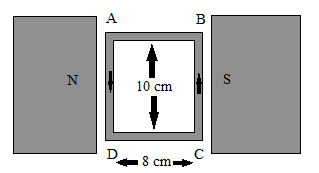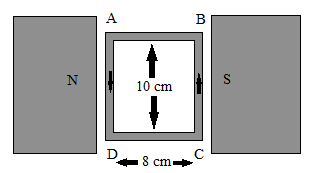
A 100 turns coil shown in figure carries a current of 2 amp in a magnetic field 0.2 Wb/m2. The torque acting on the coil is

A. 0.32 Nm tending to rate the side AD out of the page
B. 0.32 Nm tending to rate the side AD into the page
C. 0.0032 Nm tending to rate the side AD out of the page
D. 0.0032 Nm tending to rate the side AD into the page
Answer
221.1k+ views
Hint:To solve this question, we are going to use the mentioned concept. The magnetic moment in a loop can be defined as the product of the current flowing and the area of the rectangular loop. Coil carrying current, number of turns is given and current is given, measure the magnetic moment. The magnetic moment is a vector quantity.
Formula Used:
$\tau = NIAB$
Complete answer:
We have been provided in the question that,
A 100 turns coil shown in figure carries a current of 2 amp in a magnetic field 0.2 Wb/m2.

Magnetic moment determined mathematically,
$\mu = IA$
Here, A is the rectangular loop's area, and I is the current flowing through the loop.
As a result, the cross product of the magnetic moment and the magnetic field determines the torque applied to a current-carrying coil when it is put in a magnetic field.
$\tau = \mu \times B$
Magnitude of the torque is given by
$\tau = NIAB$
Where N is the number of turns, I is the current, A is the area of the loop, B is the uniform magnetic field.
Substituting the value, we get
$\tau = 100 \times 0.2 \times 2 \times (0.08 \times 0.1)$
$ \Rightarrow \tau = 0.32Nm$
Direction can be found using Fleming’s left-hand rule, according to this, the thumb gives the direction of the conductor's motion, the index finger gives the direction of the magnetic field, and the direction of the induced current is indicated by the middle finger. Fleming's left-hand rule, which states that if we stretch the thumb, forefinger, or the index finger and the middle finger so that they are mutually perpendicular to each other.
Hence, option A is correct.
Note: The force that can cause something to revolve around an axis is measured in torque. Torque accelerates an object in an angular direction, much like force does in linear kinematics. A vector quantity that can be static or dynamic is torque.
Formula Used:
$\tau = NIAB$
Complete answer:
We have been provided in the question that,
A 100 turns coil shown in figure carries a current of 2 amp in a magnetic field 0.2 Wb/m2.

Magnetic moment determined mathematically,
$\mu = IA$
Here, A is the rectangular loop's area, and I is the current flowing through the loop.
As a result, the cross product of the magnetic moment and the magnetic field determines the torque applied to a current-carrying coil when it is put in a magnetic field.
$\tau = \mu \times B$
Magnitude of the torque is given by
$\tau = NIAB$
Where N is the number of turns, I is the current, A is the area of the loop, B is the uniform magnetic field.
Substituting the value, we get
$\tau = 100 \times 0.2 \times 2 \times (0.08 \times 0.1)$
$ \Rightarrow \tau = 0.32Nm$
Direction can be found using Fleming’s left-hand rule, according to this, the thumb gives the direction of the conductor's motion, the index finger gives the direction of the magnetic field, and the direction of the induced current is indicated by the middle finger. Fleming's left-hand rule, which states that if we stretch the thumb, forefinger, or the index finger and the middle finger so that they are mutually perpendicular to each other.
Hence, option A is correct.
Note: The force that can cause something to revolve around an axis is measured in torque. Torque accelerates an object in an angular direction, much like force does in linear kinematics. A vector quantity that can be static or dynamic is torque.
Recently Updated Pages
[Awaiting input: Please provide the content from "Ask AI Response," "Competitor 1," and "Competitor 2," so I can perform the analysis and synthesize the requested metadata and headings.]

Young’s Double Slit Experiment Derivation Explained

A square frame of side 10 cm and a long straight wire class 12 physics JEE_Main

The work done in slowly moving an electron of charge class 12 physics JEE_Main

Two identical charged spheres suspended from a common class 12 physics JEE_Main

According to Bohrs theory the timeaveraged magnetic class 12 physics JEE_Main

Trending doubts
JEE Main 2026: Application Form Open, Exam Dates, Syllabus, Eligibility & Question Papers

Derivation of Equation of Trajectory Explained for Students

Hybridisation in Chemistry – Concept, Types & Applications

Understanding the Angle of Deviation in a Prism

How to Convert a Galvanometer into an Ammeter or Voltmeter

Degree of Dissociation: Meaning, Formula, Calculation & Uses

Other Pages
JEE Advanced Marks vs Ranks 2025: Understanding Category-wise Qualifying Marks and Previous Year Cut-offs

Dual Nature of Radiation and Matter Class 12 Physics Chapter 11 CBSE Notes - 2025-26

Ideal and Non-Ideal Solutions Explained for Class 12 Chemistry

Understanding the Electric Field of a Uniformly Charged Ring

Understanding Electromagnetic Waves and Their Importance

Essential Derivations for CBSE Class 12 Physics: Stepwise & PDF Solutions




